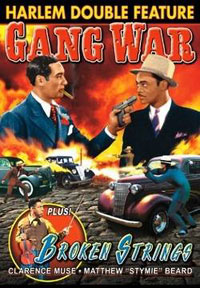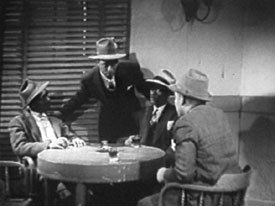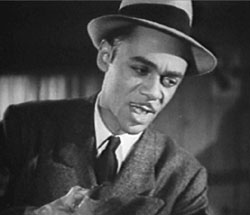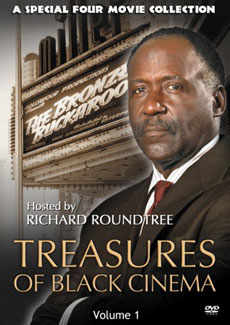Treasures of Black Cinema (2005) consists of just a tiny bit of new film footage of host Richard Roundtree introducing two movies on each of two discs, four films in all.
 Roundtree informs us of a few simple facts, like over five-hundred "race films" were made from 1920 to 1950, of which a significant fraction survive. Roundtree informs us of a few simple facts, like over five-hundred "race films" were made from 1920 to 1950, of which a significant fraction survive.
He introduces The Devil's Daughter (1939) & when that film runs its course he introduces Gang War (1940). The two films have no contextual relationship beyond the all-black-casts, as one is a mild voodoo tale, the other a gangster flick.
Volume two of Treasures of Black Cinema has Roundree introducing the Herb Jeffries western The Bronze Buckeroo (1939) mismatched with Mantan Morland's comedy Up in the Air (1940).
Gang War is additionally available in one of the "Harlem Double Bill" series together with Broken Strings (1940) starring Clarence Muse.
Such films were not taken seriously by mainstream critics until long after the Civil Rights movement put a stop to Jim Crow. In their day, these films were shown in black-owned theaters in segregated neighborhoods, or on "colored night" in white-owned theaters of the south and the northern "black belt" of Chicago, St. Louis, Detroit, & New York.
Or they were exhibited, especially in the southwest & west, in "regular" theaters with the upper balcony "reserved" for African Americans.
It is interesting, or perhaps the word is pathetic, to imagine these "race films" in theaters that permitted black folk to sit only in the upper peanut gallery, with the main floor of the cinema house seating one or two white guys.
A few black-cast films were made for genuinely broad audiences, i.e., Cabin in the Sky (1943), & were Hollywood films with white creative teams behind the scenes.
But more often they were genuinely independent productions by black-owned shoestring production companies, & their capacity to do so much with so little is something that even modern-day independent filmmakers could do well to study.
 Gang War, aka Crime Street, opens with fist fighting in a cafe between two gangs over juke box territory. Organized crime really did control jukeboxes throughout major American cities at least until the 1970s. Gang War, aka Crime Street, opens with fist fighting in a cafe between two gangs over juke box territory. Organized crime really did control jukeboxes throughout major American cities at least until the 1970s.
Bob "Killer" Meade (Ralph Cooper, later the producer of several "race films") is a dandy with the hots for showgirl Maizie "Sugar" Walford (Gladys Snyder). Meade overthrows the big boss (Maceo Bruce Scheffield), eager to take over the gang. The mobsters dress just like white gangsters in Hollywood films rather than like Harlem racketeers.
A montage shows Killer's rise, the gang war, the arrest, the trial, with the montage ending on the verdict "not guilty." Maizie naively believes Meade isn't all that bad. In fact he's much worse now that he's gotten away with murder with an acquital.
A lot of the "action" is just sound effects behind newspaper headlines & its otherwise a film of what Mr. T calls jibber-jabber, with occasional smoky gunfights. Killer Mead's relationship with Maizie comes closest to being a story. They're both good looking actors who give a degree of sexiness to the tale of the naive showgirl & the wicked thug.
 Bits of a fun floor show while Killer & his gal are at the club provide effective diversion. There's a fine tapdancer (Willie Covan, also seen tapping in The Duke is Tops, 1938), a beautiful chorus line, an exotica act with African drumbeat, a gorgeous lead dancer (Marie Bryant, who also did her African exotica dance in The Duke is Tops), & revealing costumes. Bits of a fun floor show while Killer & his gal are at the club provide effective diversion. There's a fine tapdancer (Willie Covan, also seen tapping in The Duke is Tops, 1938), a beautiful chorus line, an exotica act with African drumbeat, a gorgeous lead dancer (Marie Bryant, who also did her African exotica dance in The Duke is Tops), & revealing costumes.
If all that is a decent representation of Harlem club-entertainment, then good golly those were great times for niteclubbing.
Maizie at gunpoint is forced by rival gangster Lew Baron (Lawrence Griner) to call Killer Meade & sing a composition by Lou Porter & Johnny Lance, "Remember the Night." Maizie can't sing worth a damn, but as Killer's listening on the phone, he's just so happy to hear his beloved's performance, not knowing she's being threatened. It's just about the film's strongest scene, scary & emotional.
"Boys, we got some exterminatin' to do," is Killer's eventual assessment of the situation. A police lieutenant (Jess Lee Brooks), friend to Meade since childhood, tries to convince Killer to get out of the rackets. And Maizie went to Lieutenant Holmes to try to get him to keep her boyfriend from killing Baron.
But nothing can stop the pending shoot-out & the end to Killer Meade's reign of terror. There's enough built-in tragedy to this thing to make the rooftop action climax effective film noir coolness in the end, & whatever the faults of this film, Ralph Cooper is good enough at being the Cagneyesque anti-hero that Gang War is assuredly entertaining.
copyright © by Paghat the Ratgirl
|

 Roundtree informs us of a few simple facts, like over five-hundred "race films" were made from 1920 to 1950, of which a significant fraction survive.
Roundtree informs us of a few simple facts, like over five-hundred "race films" were made from 1920 to 1950, of which a significant fraction survive.
 Bits of a fun floor show while Killer & his gal are at the club provide effective diversion. There's a fine tapdancer (Willie Covan, also seen tapping in
Bits of a fun floor show while Killer & his gal are at the club provide effective diversion. There's a fine tapdancer (Willie Covan, also seen tapping in